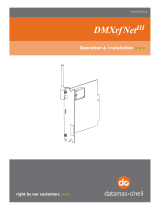
TABLE OF CONTENTS
GETTING STARTED ................................................................................................................................... 1-1
Audience .............................................................................................................................................. 1-1
System Requirements ........................................................................................................................... 1-1
Specifications ....................................................................................................................................... 1-2
Verifying a Wireless Connection ............................................................................................................. 1-2
Printing a MonarchNet2 Test Label......................................................................................................... 1-2
USING A WEB BROWSER .......................................................................................................................... 2-1
Logging In ............................................................................................................................................ 2-1
Configuring the Printer .......................................................................................................................... 2-3
Changing the Printer Setup ................................................................................................................ 2-3
Changing the System Setup ............................................................................................................... 2-4
Configuring the Network Settings ........................................................................................................... 2-5
Changing TCP/IP Settings .................................................................................................................. 2-5
Changing SNMP Settings ................................................................................................................... 2-6
Changing Wireless Settings ................................................................................................................ 2-7
Basic Security Configurations ............................................................................................................. 2-8
Using WEP........................................................................................................................................ 2-9
Configuring Certificates ................................................................................................................... 2-10
Alerts ................................................................................................................................................. 2-11
Receiving An Alert ........................................................................................................................... 2-12
Reset/Reboot Network ......................................................................................................................... 2-12
Reading the Virtual Panel .................................................................................................................... 2-12
Using Custom Commands .................................................................................................................... 2-13
Using Custom Data ............................................................................................................................. 2-14
Admin Settings ................................................................................................................................... 2-14
Enable Web Timeout ........................................................................................................................ 2-14
Changing the Password ................................................................................................................... 2-15
CONSOLE COMMANDS .............................................................................................................................. 3-1
Conventions ......................................................................................................................................... 3-1
Accessing Telnet Console Mode ............................................................................................................. 3-2
Help Commands ................................................................................................................................... 3-3
General Commands ............................................................................................................................... 3-4
Setup Commands .................................................................................................................................. 3-5
RFID Commands ................................................................................................................................... 3-7
802.11b/g Wireless Commands .............................................................................................................. 3-8
TCP/IP Commands ................................................................................................................................ 3-8
SNMP Commands ................................................................................................................................. 3-9
Using the Network Packet ...................................................................................................................... 3-9
TROUBLESHOOTING ................................................................................................................................. 4-1
Printing a MonarchNet2 Test Label......................................................................................................... 4-1
General Troubleshooting Information ...................................................................................................... 4-2
Troubleshooting Wireless Configuration Problems ................................................................................... 4-3
GLOSSARY ............................................................................................................................................... G-1




















